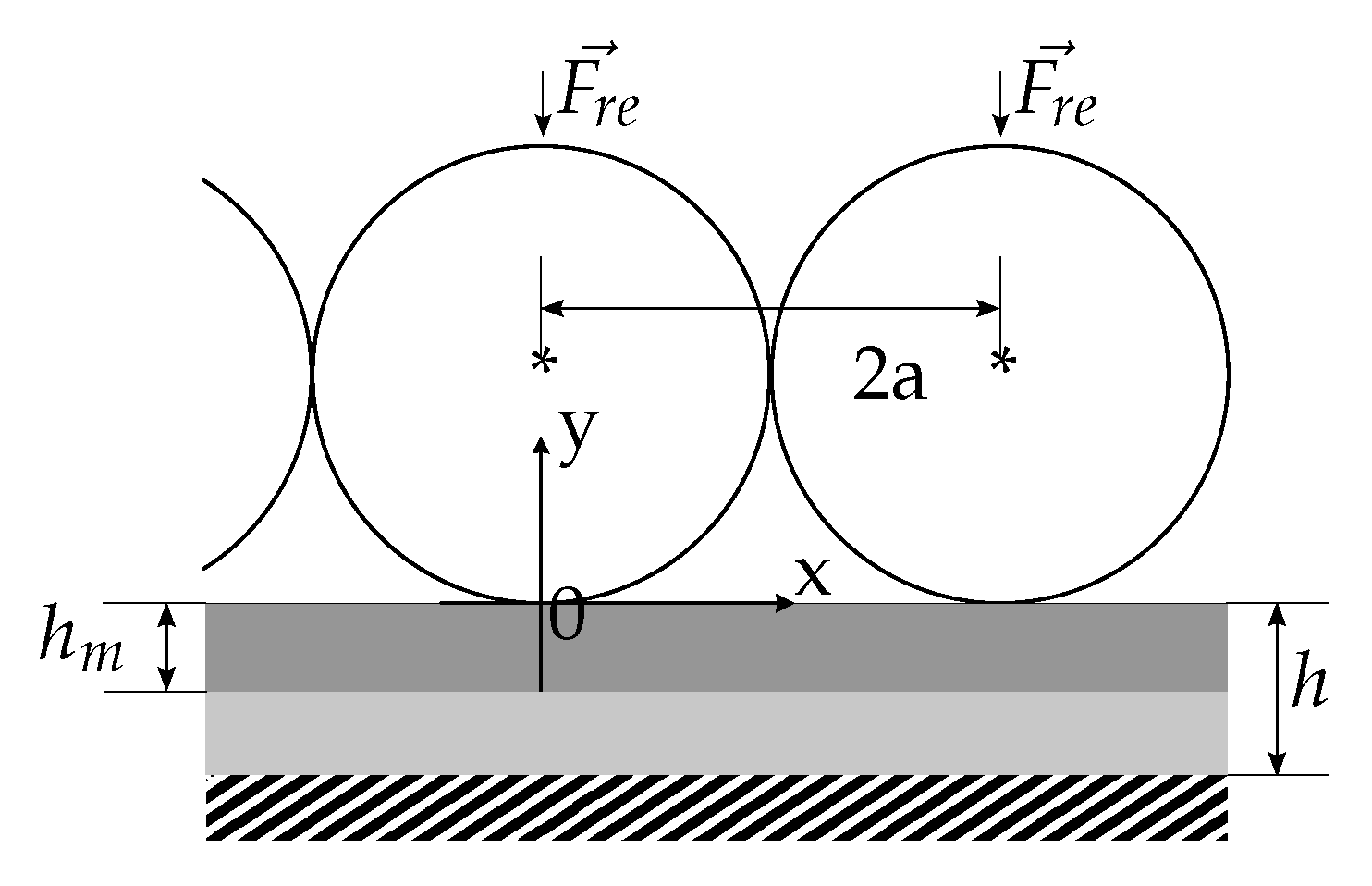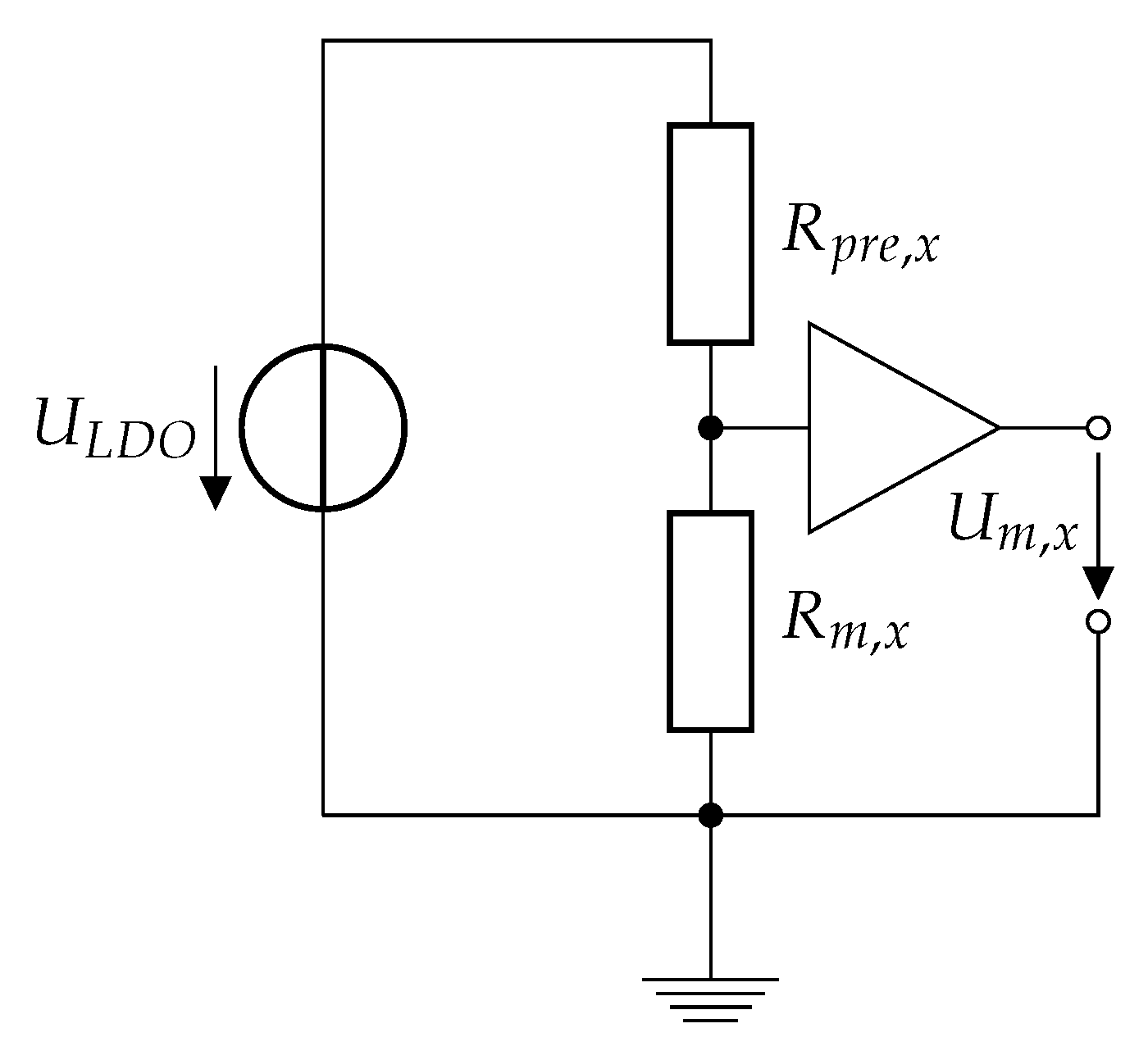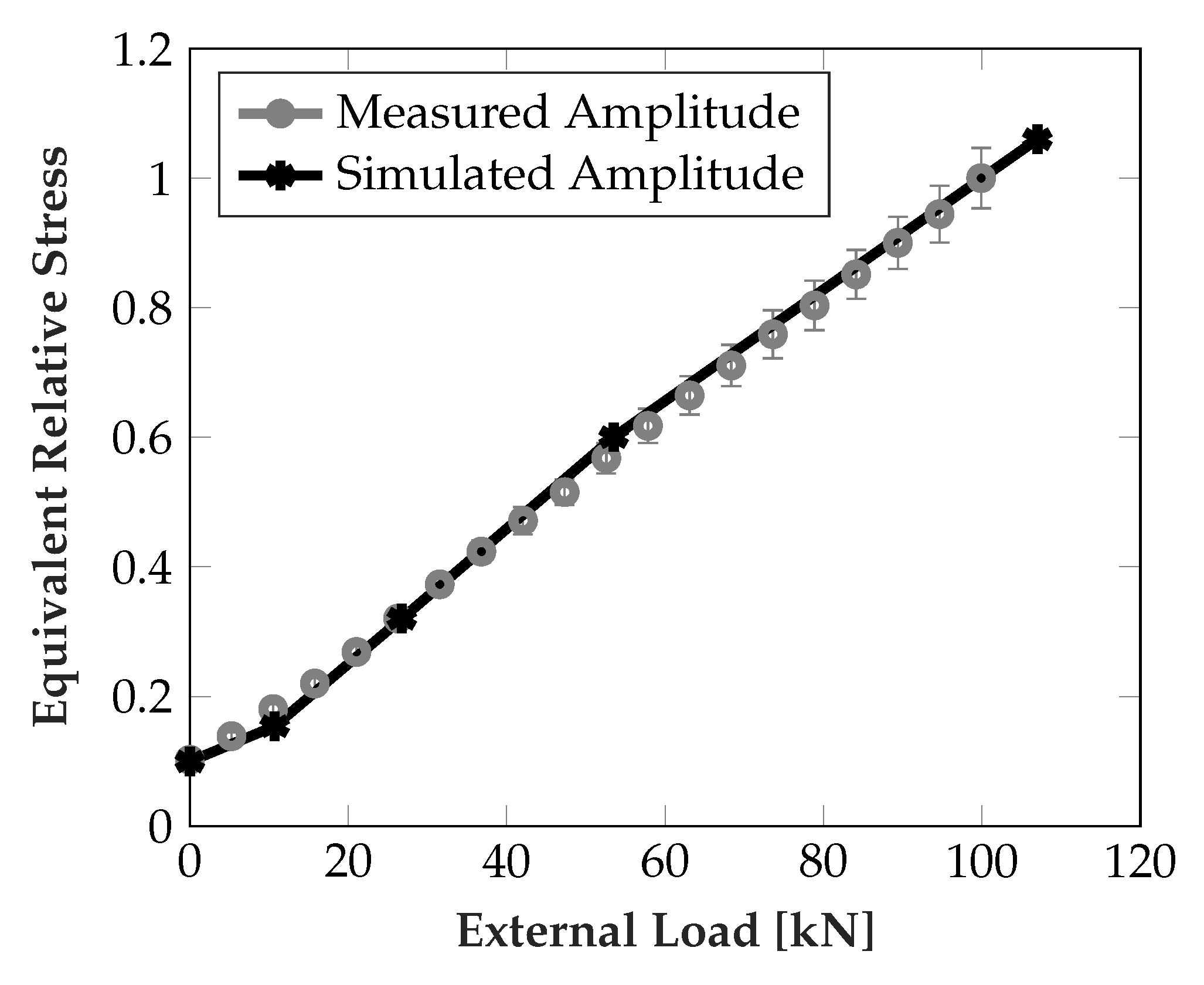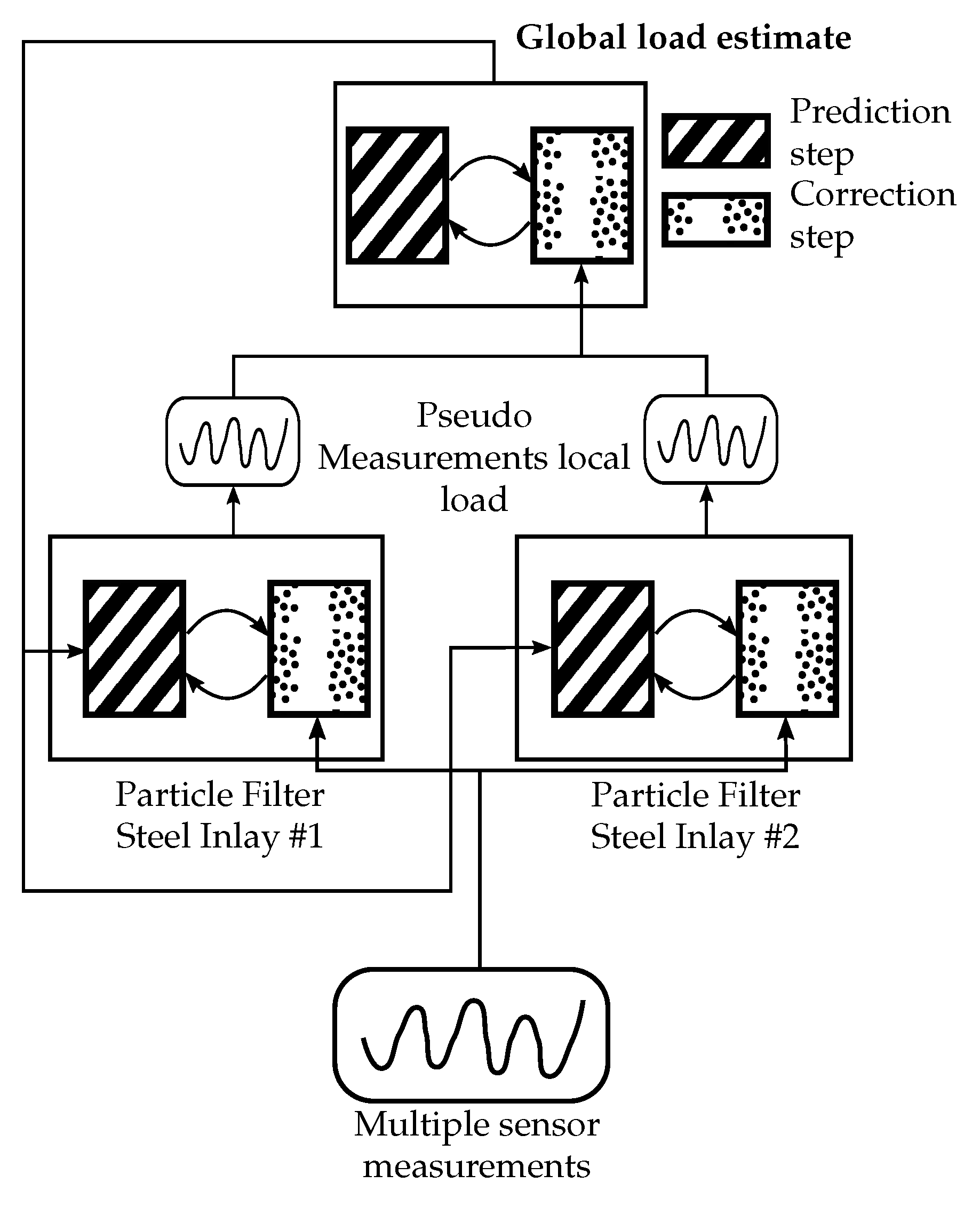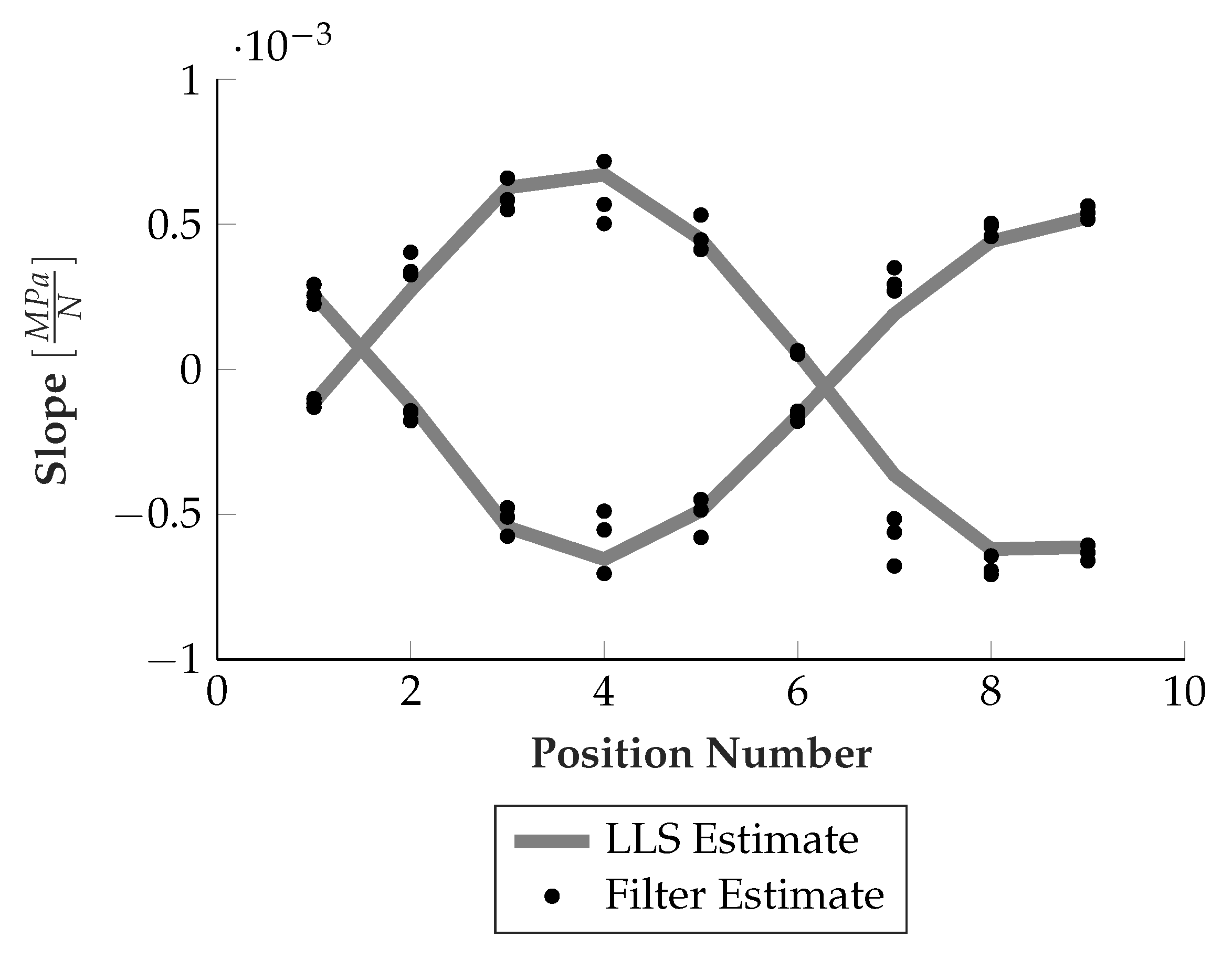When measuring the stresses directly related to the contact zone, the applied sensor principle has to meet two fundamental requirements, high k-factor and high durability. The k-factor describes how much the sensor signal changes relative to the strain, i.e., change in size, caused by the force to be measured, as in Equation (
1). When the sensor is put directly into the force flux, it should not require significant strain to produce measurable signal changes, otherwise the linear guide as a whole will yield beyond its specifications. On the other hand, stresses close to the contact center can reach high values, requiring a very rugged sensor itself and also reliable coupling to the steel substrate, otherwise e.g., delamination can occur. Taking this into consideration, the DiaForce
® coating by the Fraunhofer Institute for Surface Technology was chosen. A similar sensor was already successfully used by [
25]. There it was used on a pin in a double nut arrangement to monitor preload. The sensor was not used to detect the current loading, or close to the rolling element contact, as it is in this work. The sensor is based on an amorphous carbon layer with high sp3/sp2 hybridization ratio, commonly referred to as diamond like carbon (DLC), which is known to exhibit significant piezoresistive behavior. The exact k-factor depends on the coating parameters and can reach values up to 1200 [
26,
27]. In order to calculate the mechanical stress from the electrical resistance, calibration data of the elements towards regarding the piezoresistive effect and the temperature dependence is required. The origin of the piezoresistive effect is not fully understood, but can be approximated to result in a linear dependency of the resistance
R on the strain
. Further the dependency of the resistance on the temperature
T follows Arrhenius behavior. Both dependencies are shown in [
28], yielding the following parametric equations for the calibration process:
where
is the reference resistance in the absence of (external) strain at reference temperature
,
k is the gauge factor and
B is the coefficient describing the temperature dependency. Ref. [
28] also states the independence of the gauge factor on the temperature, at least in the range of 23
C <
T < 60
C. DLC coatings have been already studied for use in bearings, e.g., in [
29], and a thorough overview of their tribological properties is found in [
30].
On the backside, the sensors were still close to the contact zones, with the previously described benefits for load estimation, but are subject to milder stress levels (peak von-Mises equivalent stresses approx. only half of those in the direct contact according to FEM simulations), aiming for higher durability and longevity of the sensor system.
2.2.1. Analytical Derivation of Stresses
The mechanical stresses caused by loading the runner block are dependent on numerous factors, e.g., the exact geometry of the runner blocks. Therefore an analytical derivation of the full model would be too involved for practical applications, making numerical FEMs more attractive. Anyway, an analytical solution can be derived for a highly simplified case, which is still useful for a general analysis of the problem, showing the dependencies of the mechanical stress, i.e., also the sensor signals, on the applied force and relative position of the rolling elements. The sensor data was still evaluated against FEM simulation data later on.
The overall procedure described in the following is largely based on the work for a single body/layer in [
31], extending it by the notion of using joint boundary conditions to model multiple connected bodies briefly mentioned in [
32]. This way, the steel inlay can be modeled to rest upon an elastic body (i.e., the runner block), which in turn, for simplicity, rests on a rigid foundation. In reality, the linear guide system will deform when load is applied. This contradicts the rigid foundation assumption. Bringing the sensor close to the rolling elements should diminish such effects. The validity of this assumptions will be checked by comparing the analytical results to FEM data derived from a more realistic model. For the simplified case a single, infinitely long steel inlay was assumed, on which a periodic load, i.e., by infinitely many, equally spaced cylindrical rolling elements, is applied. Further, the problem was reduced to a two dimensional one by assuming the rolling elements and the steel inlay to be infinitely wide and the stresses to be constant along this axis. A section of the problem is sketched in
Figure 3 with the corresponding coordinate system. On the
x-axis the elements will occur periodically until infinity.
There are 8 boundary conditions to be defined. Traction boundary conditions were chosen such that shear stresses
are 0 at all body interfaces. Displacement
in y direction was forced to 0 at
by the rigid foundation. Displacement as well as stress
in the y-direction was modeled to be ideally transferred between the two bodies, i.e., were set as equal. The stresses at the contact with the rolling elements was given according to a model chosen for the contact zone, leading to pressure profile
. For simplification, the pressure profile applied by the individual rolling elements was modeled to be uniformly distributed over the contact width. This represents a periodic rectangular pulse, the width of which is derived from the classical contact theory [
16] as
, where
is the loading force per rolling element,
a is the radius of the rolling elements,
is Poisson’s Ratio,
E is Young’s Modulus and
l is the real length of the rolling elements. This leads to more convenient expressions in the Fourier domain than the original half-circle pressure distribution, especially simplifying the back-transformation step. The pressure
is then defined as
where
is the Heaviside step function.
The problem is then solved by Fourier transformation of the pressure profile and the governing Navier-Lamé equations and solving for the displacement
u leading, together with the boundary conditions, to an equation system, linear in the coefficients to be determined (again, see [
31] for the derivation for a single body):
relating to strains
and stresses
via
The solution is then transferred back into the spatial domain. Following all those steps, one obtains a series representation of the stresses in the spatial domain as (here just the normal stresses):
with
where
where
and
are Lamé’s constants. The formulas in Equation (
7) only describe the stresses at
, i.e., at the location of the sensors. This is for the sake of compactness of formulas at this point, but of course stresses at different depths can also be calculated with the same method. It can be shown that in our case of having a “thick” layer/steel inlay, i.e., of height
in the order of magnitude of the periodicity
a of the pressure profile, the higher order parts (
) of the signal vanish quickly and can thus be neglected for
. The sensor signal at a specific relative position of the rolling elements can then be derived by integrating over the sensor length in
x-direction at
, i.e., determining the equivalent mechanical stress. This stress manifests itself in the measurement resistance via the piezoresistive effect. The results are largely compliant to the FEM simulation results, as it can be seen in
Figure 4. Only an offset on the stresses in y-direction exists in FEM data,
, which is not present in the analytical solution of the simplified problem. The offset originates from the finite dimensions of the steel inlay in the real/FEM problem. Without torque being applied, this average stress
is the load per raceway divided by the steel inlay area. Respecting this, the analytical results are very close to the FEM results. The term
predicts, consistently with the FEM results, near linear scaling of the stresses with the applied force for
. Due to the dominance of the
portions, the stresses also consistently follow a near sinusoidal wave in
x-direction with a period of
, i.e., the spacing and diameter of the rolling elements. The model, in extended fashion, can also be used to analyze the influence of material properties and coupling of the sensor layer and any additional layer, as e.g., a thin glue layer below the steel inlay, by again applying joint boundary conditions.
The expected sensor signals can then be calculated from the strain-resistance relation in Equation (
1) (easily transferable to a stress-resistance relation assuming isotropy of material properties) and corresponding calibration data for
k and
. Formulating stress dependency was chosen as in the calibration setting, obtaining stress was more straight-forward than for strain. So far it has been shown that results obtained via FEM and the simplified analytical description are largely compliant. This implies that the assumption of the foundation being a rigid body is good enough for the model to deliver useful results in this setting. In the following, measurement data will be compared to FEM data. Compliance between FEM and measured data will also imply validity of the analytical derivation.
2.2.2. Measurement Setup
To evaluate the sensor performance and verify compliance with FEM models and analytical calculations, the runner blocks were loaded with a perpendicular, uniaxial load varying from 0 kN to 100 kN. The load was recorded using a proprietary strain gauge based load cell This cell was regularly calibrated and verified to provide minimum ±1 kN accuracy over the whole measurement range. The mechanical setup is sketched in
Figure 5.
Since the sensor signal is dependent on the relative position of the rollers to the individual sensors, the runner block was moved 1 mm between load cycles, causing a 0.5 mm displacements of the rollers. A distance of 12 mm was covered in 13 repetitions. In order to generate more data per test run and facilitate the mechanical setup, two runner blocks on two rail guides, screwed together on there bases, were loaded simultaneously. This leads to a total of four raceways being in the force flux.
For evaluating the sensor resistance of sensor element
x, a shunt resistor
(temperature coefficient of resistance 50
) was used to build a voltage divider. The circuit was fed by a voltage of
V, supplied by a constant voltage low dropout regulator (LDO). The voltage
over the resistance
was then fed to a buffer and captured with a sampling frequency of 1 kHz. The whole circuit is depicted in
Figure 6. Each sensor element has a dedicated shunt resistor and buffer element, but all were fed by the same voltage source. Since in the scope of this paper only near-stationary cases are considered (slow change rate of the applied force when standing still,
5 kN/s, and slow velocity
v < 50
when in motion), only considering the real part of the signal, i.e., ignoring e.g., parasitic capacitances is feasible.
In order to be able to calculate an equivalent mechanical stress from the electrical resistance of the sensors, the sensor elements were provided together with calibration data. This is the sensor response to a direct perpendicular load, homogeneously applied to the sensor area. The result is two parameters, offset and slope, per sensor for a linear fit. Temperature dependency can be fitted to an exponential curve, using another two calibration parameters per sensor (see Equation (
1)).
2.2.3. Cross Sensitivity
As it was expected from the literature [
24], the sensors show high temperature dependency. Further, due to the sensors’ amorphous nature on a micro scale, the macroscopically observed piezoresistive effect is largely isotropic, as also shown in [
33]. Therefore, the sensor is not only sensitive to the directly load related strain introduced by the rolling elements, but also to the deformation of the runner block, or more precisely the steel inlay. Runner block deformation is dependent on additional external factors, e.g., how the moving machine part is mounted onto it. The decision in favor of this measurement method was based on presumable independence of such factors, which would take another layer of abstraction to compensate. A way to eliminate those stresses has to be found. Finally, when the rolling elements pass over the sensors, the obtained signal is highly dependent on the relative position of the rollers to the individual sensors (see Equation (
7)). In order to measure the actual load, the roller location has to be estimated from the sensor signals as well.
The roller location sensitivity, if one is able to determine this location reliably, can be exploited to compensate most parts of both temperature dependency and cross-sensitivity, if the difference between two neighboring sensors is used instead of a single one. For this, the sensors have to be small enough for the roller position to have enough impact, i.e., should be in the approximate range of the roller size. The pairs also have to be very close. If this is given, any temperature will have nearly the same impact on the neighboring sensors, as will any stress introduced by global deformation of the runner block. In the case of the prototype the sensor size was 0.5 mm × 2 mm, where the 2 mm span was in direction of the roller movement, roller diameter was 5 mm. Compensation can then be achieved by numerically calculating the difference of the sensor pair signals and using this difference signal for further calculations. Alternatively, a sensor pair can already be electrically connected to form a bridge arrangement. For more flexibility the numerical difference was chosen in the prototype arrangement. In both cases, the effect is comparable to what is exploited in usual full-bridge strain gauge arrangements. Since the sensors are not trimmed for this, and trimming under load is very unlikely to be feasible, the sensors differ in their parameters. Thus full compensation with this method was not achieved. Nevertheless, the influence is highly reduced: for confirmation, the reduction of these parasitic stresses has to measured, which is hard to achieve directly, as it is superimposed with the actual rolling element related signal on the loaded raceways. When loading two raceways of the runner block with a perpendicular force on the same, the remaining two are unloaded. The runner blocks were preloaded for better mechanical characteristics, which means the raceways, which were not in the force flux, were unloaded after a certain amount of force was applied, which is called the point of preload liftoff from here on. For higher forces, no stress originating from the rollers can be measured by the sensors, making the unloaded raceways usable for assessing the cross-sensitivity compensation performance. The results are shown in
Figure 7, depicting the change rate of the equivalent stress over an external load, at the point of maximum sensitivity regarding the rolling element position.
The resistance of the sensor elements was converted to equivalent stress using a linear calibration curve obtained by direct surface perpendicular loading. Then the mean and standard deviation was calculated over all sensors on both runner blocks, each having four raceways with three sensor areas. No sensitivity towards the non rolling element related stress, i.e., the ideal case, would imply a change rate of 0
. From
Figure 7 good compensation performance of the difference signal approach can easily be seen. The mean change rate over all evaluated load points was reduced from approx. 0.214
to approx. 0.028
, equaling a reduction by approx. 86.9%. Additionally, an increased signal amplitude of the difference signal, as shown in
Figure 8, further increases the ratio of useful signal to unwanted cross sensitivity.
Figure 9 shows the performance of the temperature compensation achieved by using the difference signals.
The numbers are obtained directly from the calibration data for the exponential temperature dependency. The enormous predominance of the temperature dependent signal compared with load dependent signal made compensation by temperature measurement nearly infeasible even for small errors. A linearized mean temperature dependency from 20 °C to 80 °C of approx. using the difference signal compared to approx. using single sensors could be achieved. This reduction of temperature sensitivity by approx. 92.5% promises highly improved correction results.
2.2.5. Comparison with Simulation
In order to prove the suggested measurement principle can be applied successfully, one has to show that the obtained signal is actually originating from the rolling element contact. The expected stresses were already described analytically, and compliance with FEM results was shown. If the experimental results agree with FEM results, and thus also the analytical model, the measurement method is successfully applied. In the simulation, the strain was obtained for a steel inlay without the coating, assuming neglectable influence on the overall mechanic response. During calibration unidirectional strain, perpendicular to the surface normal, is assumed. The exact relationship between simulated and measured signal might depend on e.g., deviations in material properties. Thus the following is meant to show agreement in shape, i.e., up to a factor of proportionality.
The signal when the runner block is in motion is depicted in
Figure 10, at an external load of approx. 50 kN. Here the signal was recorded for approx. 100 mm, leading to approx. 10 repetitions. The superposition after conversion to mechanical stress via calibration data and normalization is depicted. The measured difference signal actually showed an offset from the 0 MPa mean, probably indicating a small error in calibration data. This can be easily compensated also in a real application, as it was done for
Figure 10.
Figure 11 shows the simulated and measured signal swing of the difference signal over different external loads (simulated: 0, 0.1C, 0.25C, 0.5C, C, where C is the maximal specified load). The signal swing is taken as the difference between minimum and maximum when the rolling elements move over the sensors. For the measured signal the mean and one standard deviation is indicated (sampling from two sensor pairs on two steel inlays with three repetitions). For both simulation and measurements the sensor response is largely linear w.r.t. to the external force and show excellent agreement in general.
The signal in movement is a measure for the spatial agreement of simulation and measurements, i.e., distribution of strains under the rolling element, showing excellent matching. In
Figure 10 it should be mentioned that the distance of rolling elements in the FEM simulation was 5.3 mm (i.e., 0 mm more than the minimum distance). Additional noise is introduced in the measurement by a slightly varying distance between the rolling elements.
2.2.6. Estimation of Roller Locations
While measuring the strain directly introduced by the rolling elements can be advantageous by being close to the point of load transfer, it also provides the challenge of signal dependency on the relative rolling element position, although this can also be exploited for signal correction, as shown above. In order to demonstrate real practical applicability of the load measurement principle, an algorithm estimating both the roller locations and the force acting upon the carriage was developed. The challenge is to estimate the force under roller location uncertainty, for two rollers, from only two difference signals per steel inlay. This clearly leads to an under determined and nonlinear equation system. For the estimation per steel inlay, in order to cope with the nonlinearities, a particle filter was employed. This filter produces a statistical estimate in the three dimensional state space. These two estimates, one per steel inlay in the force flux, are then taken as pseudo-measurements for a superimposed Kalman filter. The Kalman filter estimate is then fed back to the state space exploration, or prediction, part of the local particle filters. This way, sensor fusion over the four difference signals is realized. The exact implementation would be beyond the scope of this paper, the working principle is shown in
Figure 12. For the mapping of the measurements to the state space, either a phenomenological function or one based on
Section 2.2.1 can be used.
To test the performance of the algorithm, the algorithm was provided with sensor data from nine different runner block positions, 1 mm apart each, again with increasing load from 0–100 kN. The measurements were repeated three times. Since the behavior for a given position is nearly linear, the estimated slopes were compared with a linear least squares (LLS) fit (i.e., virtually known position), the result is depicted in
Figure 13. Also the relative runner block movement can be extracted from the estimated position of one of the rolling elements, which is shown in
Figure 14.
Both estimates delivered fairly accurate results, with only some outliers, e.g., at position 7. Taking into account the underlying difficult estimation task as described above, this indicates real applicability of the technology even for more complex and dynamic load situations, if the sensor layout and algorithm is further developed.


